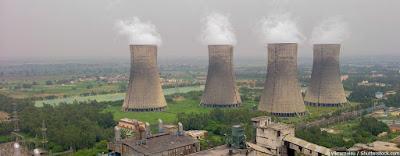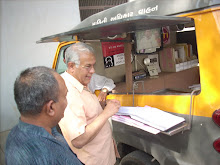IndiaSpend:
Bengaluru: Friday, September 13, 2019.
In
addition to polluting the air and warming the planet, India’s thermal power
plants are consuming excessive amounts of water, in many cases beyond the
permissible limits set by the environment ministry, according to information
obtained through the Right to Information Act (RTI).
About
51% of 156 thermal plants across 12 states whose data could be obtained
declared themselves compliant with water norms early this year, said the RTI
response received by the Manthan Adhyayan Kendra, a research centre that
analyses water and energy issues in India.
This
excessive water consumption is causing water stress, we explain later, which
affects households, farms and industries in the plant’s neighbourhood. It is
also resulting in the shut-down of the thermal plants. Upto 40% of India’s
thermal plants are located in areas facing acute water shortages, according to
an analysis by the World Resources Institute (WRI), and are worsening the water
crisis there. In this analysis, WRI has categorised ‘thermal power plants’ as
those where steam is generated and water cooling is needed. This would include
coal, oil, biomass and nuclear. In total, India has 399 such plants.
About
600 million Indians live with “high-to-extreme water stress”, where over 40% of
annually available surface water is used every year, according to a 2018 study
by government think-tank Niti Aayog, as IndiaSpend reported on June 25, 2018.
Upto
19% of the remaining plants declared themselves noncompliant, as per the RTI
responses. The others either did not supply any data or offered insufficient
information. Some plants were found shut. Also, 14 plants reported using sea
water which exempts them from complying with water norms.
As
of August 30, 2019, there were 269 thermal power plants in India, according to
the Central Electricity Authority. Taken together, these plants consume 87.8%
of the total amount of water consumed by the industrial sector, according to a
study conducted by The Energy and Resources Institute (TERI). To put this in
perspective, such amounts of water could fulfil the water needs of four cities
for two days.
Renewable
energy units cause far less water stress: Solar plants, for example, consume
only a fraction of the water used by thermal plants, as we explain later, and
wind energy does not need any water at all.
The
detailed RTI response and its analysis have been documented in a report
released by Manthan on July 1, 2019. Manthan had sought but did not receive
information from West Bengal, Karnataka and Rajasthan.
Two-way
problem of water stress and power shortages
Thermal
power plants in India use water for cooling purposes and the disposal of fly
ash, a byproduct in combustion processes.
“The
usage of conventional technologies like burning coal to generate power requires
large quantities of water,” said Shripad Dharmadhikary, founder of Manthan
Adhyayan Kendra. “This is the first problem. Secondly, we do this [the
production of thermal power] inefficiently.”
This
excessive water use creates two interlinked problems: Thermal power plants
affect water security and are, in turn, affected by the non-availability of
water, said Shresth Tayal, a fellow with TERI. “The energy security of the
country cannot be achieved without water security,” he said.
Between
2013-17, 61 coal plants were shut down because of water shortages, resulting in
a loss of 17,000 gigawatt-hours of electricity, according to a report by the
Institute for Energy Economics and
Financial Analysis (IEEFA) that conducts research and analysis on financial and
economic issues related to energy and the environment. “National Thermal Power
Corporation’s Super Thermal Power Plant in Farakka, West Bengal and Rihand
Super Thermal Power Project in Uttar Pradesh, Parali Thermal Power Plant in
Maharashtra, Raichur Thermal Power Plant in Karnataka and Ennore Thermal Power
Station in Tamil Nadu are all located in water-stressed areas and have been
shut-down because of water storages,” said Deepak Krishnan, manager with the
energy programme at the WRI, India.
Water
consumption limits raised
Until
December 2015, there were no norms to monitor water usage of thermal power
plants. Then, on December 7, 2015, the Ministry of Environment Forest and
Climate Change (MoEFCC) issued a notification which declared that old plants
could use 3.5 cubic metres of water per megawatt-hour and those installed after
January 1, 2017 could use 2.5 cubic metres of water per megawatt-hour.
In
October 2017, the government eased the water consumption norms for even plants
that started operations on or after January 1, 2017--they are now allowed to
consume up to 20% more water than permitted earlier. Passed as amendments to
the Environment (Protection) Rules, 1986, the new rules allow plants to use up
to 3 cubic metres per megawatt-hour. This additional amount is enough to
irrigate 700 hectares of land a year.
The
average consumptive water requirement of coal-based plants with cooling towers
is about 5-7 cubic metres of water per megawatt-hour, according to the NITI
Aayog. “In terms of installed capacity and water consumed per megawatt-hour of
electricity generated, coal plants are the biggest consumers of water among
thermal plants,” Dharmadhikary explained.
“There
are technologies like dry cooling systems that have been employed in countries
like South Africa and Australia that can be used to improve water efficiency,”
Tayal said. “Plants that use this technology use as less as 0.5 to 1 cubic
metres of water per unit of electricity generated. But the point is, dry
cooling reduces the efficiency of the plant in terms of electricity production.
So, we have to strike a balance between electricity and water efficiency.”
Affect
on local communities
Efficient
alternatives have become important also because thermal power plants put other
water consumers--households, farming communities and other industries located
in the area--at risk. There have been at least four cases where local
communities were or still are in danger of losing sufficient access to water
for household use or farming because of the water strain imposed by local
thermal power plants or proposed thermal power plant projects in the area, as
per latest data gathered by Land Conflict Watch since 2017. There are also four
other cases where concerns were reported of water contamination by thermal
power plants.
The
rate at which thermal power plants are gulping water will only increase in the
coming years, according to this WRI paper. Thermal plants and other water
consumers like farms, households and other industries located in the same
watershed will end up competing for the water, it predicted.
Lack
of transparency, accountability
Till
date, compliances or lack thereof with water consumption regulations are
self-reported by individual power plants.
“There
is no real monitoring,” Dharmadhikary said. “The SPCBs [State Pollution Control
Boards] are only receiving the data filed by the power plants.” The
responsibility to monitor water consumption norms also rests on the MoEFCC in
the case of plants it clears, he added. “The conditions based on which the
clearance was granted should be monitored by the regional offices of the
ministry,” he said.
Self-disclosures
could also be made more robust to include baseline information like water
consumed in the previous year. This information can be used to make comparisons
with other data offered by verifiable evidence (water bills, for example) to
support and substantiate the disclosures, WRI suggested.
A
more wholesome solution, though, is to switch to renewable sources of energy,
as we mentioned earlier.
Solar
is a water-saving alternative. Consider this: a 1-megawatt (MW) thermal plant
operating at full capacity for a year would produce 8,760 MW per hour of
electricity while consuming 22,688 cubic metres of water [assumption or 2.59
cubic metres of water per megawatt-hour], explained Krishnan. But five solar
plants of 1 MW capacity each, operating at 20% capacity utilisation factor,
would consume 876 cubic metres of water per megawatt-hour to produce 8,760 MW
per hour of electricity.
“Compared
to cooling technology advancement or plant efficiency enhancement,
transitioning to more solar photovoltaic [technology to convert sunlight into
electricity by using semiconductors] and wind generation is the only pathway at
scale that can cut back both water withdrawal and consumption while sustaining
growth in power generation,” a WRI report stated last year.
We
emailed and telephoned the MoEFCC and the Central Pollution Control Board four
times over the last 10 days for comments on the RTI response and the kind of
actions, if any, being taken to ensure that water consumption norms are being
met. This story will be updated if and when their responses are received.
(Pardikar
is a freelance journalist from Bengaluru.)















































































